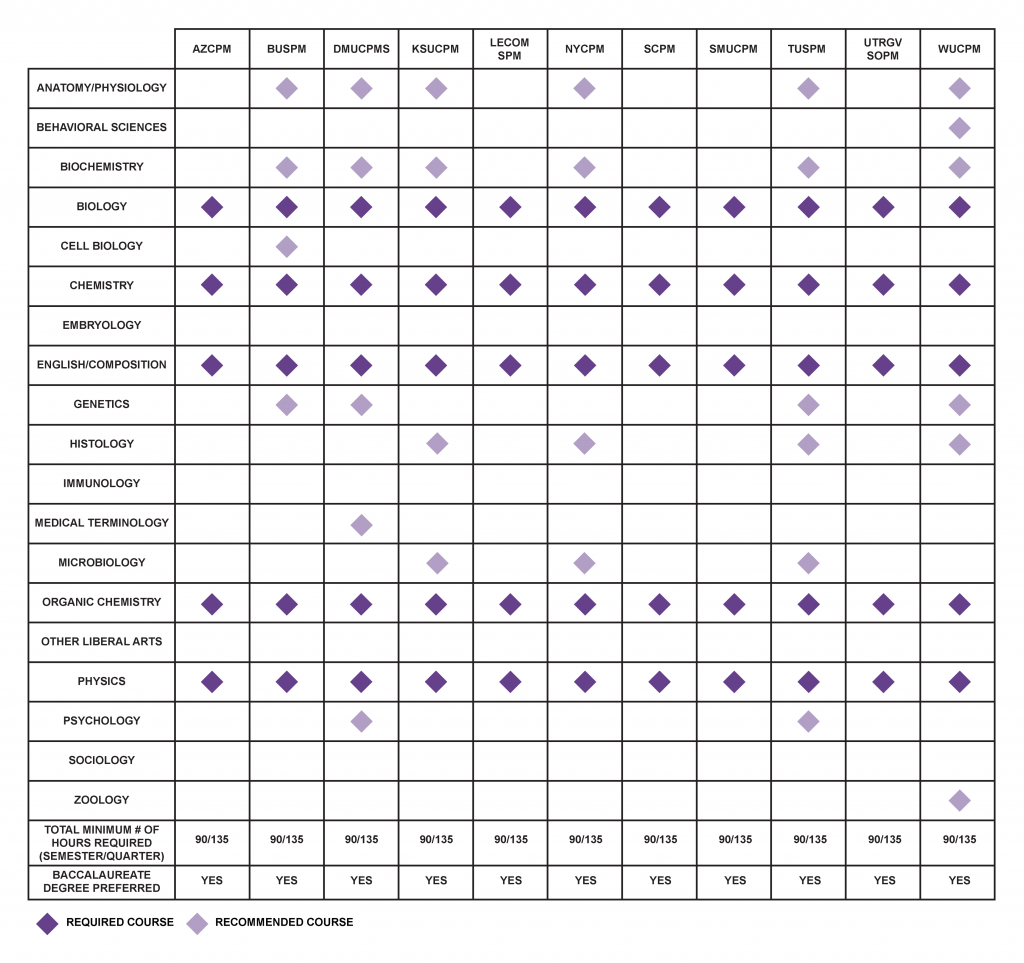The specific criteria to enter a college of podiatric medicine includes first completing at least three years (90 semester hours or the equivalent) of college credit at an accredited institution. About 98% of the students who enter a college of podiatric medicine have a bachelor’s degree. Of those having earned a degree, most will have studied a life or natural science; however, non-science majors are very successful podiatric medical students. A growing number of candidates have also completed graduate study.
Top 10 Undergraduate Majors in 2021

SUMMARY OF COURSE PREREQUISITES FOR ADMISSION TO PODIATRIC MEDICAL SCHOOL

The schools and colleges of podiatric medicine look at many factors when deciding which applicants to accept into their programs. Initially, admissions committees evaluate the applicant’s results from the Medical College Admission Test (MCAT), grade point average (GPA), letters of recommendation, and personal interview. Additional information provided in the application, including leadership, volunteerism, work experience, and demonstrable knowledge of the practice of podiatric medicine, all play a role in the final acceptance decision.
Undergraduate timeline for applying to podiatric medical colleges
It’s never too early to start thinking about a career in podiatric medicine. Both advisors and students can use this guide as a general outline of how to prepare to apply to the colleges of podiatric medicine. Please know that applicants can be successful even if they arrive at the decision to apply to podiatry later in their academic career or if they are not “science-majors.” Preparing for a career in podiatry looks a lot like preparing for a career in most medical fields.
Freshman
- Visit www.DiscoverPodiatricMedicine.com to learn more about careers in podiatric medicine. Speak with your pre-health advisor to plan coursework for pre-podiatry/pre-medical track.
- Review the AACPM College Information Page online by adding ExplorePodMed.org to your favorites.
The site includes information for all of the ELEVEN US COLLEGES OF PODIATRIC MEDICINE, admissions criteria, minimum entrance requirements, and so much more. While most schools require a minimum of one year of biology, general (inorganic) chemistry, organic chemistry, physics and English, specific requirements vary from school to school. - Complete required coursework.
- Think about which major and/or minors you may wish to pursue.
- Develop good study skills by forming study groups or attending study-skills programs.
- Maintain a competitive GPA.
- Identify extracurricular activities you enjoy or provide you with an outlet to relieve stress. Make time to participate.
- Apply to volunteer or work in a medical setting (i.e., clinic, ER, hospital) during breaks or summer months.
- Read articles, research and current interests to learn about Podiatric Medicine and Healthcare in America.
- Talk to upper-class, pre-podiatry students.
- Shadowing a DPM is excellent exposure to careers in podiatric medicine. Visit our DPM Network to locate a DPM near you: www.StepIntoPodiatry.com
Sophomore
- Visit www.DiscoverPodiatricMedicine.com to learn more about careers in podiatric medicine. Speak with your pre-health advisor to plan coursework for pre-podiatry/pre-medical track.
- Review the AACPM College Information Page online by adding ExplorePodMed.org to your favorites.
- Complete required coursework to keep you on track.
- Select major and minor courses of study. Work
out any schedule conflicts with graduation requirements and application requirements. Plan for summer school attendance if necessary. - Maintain competitive GPA.
- Continue shadowing a variety of DPMs. Visit: www.StepIntoPodiatry.com
- Research podiatric medical school entrance requirements. Review the AACPM’s College Information Page, which includes descriptions of all of the podiatric medical colleges, admissions criteria, minimum entrance requirements, and so much more.
- Look for and apply to participate in a research study which complements career objectives (with a faculty member or outside campus).
- Learn more about Podiatric Medicine (i.e., shadow-ing, classmates, advisor, or college websites).
- Join your school’s pre-podiatry society if one is available. Or, join your school’s pre-health society to learn more about careers in medicine.
- Attend pre-health activities, service opportunities, or meetings.
- Explore non-health related community service opportunities through your school or other not-for-profit agency. If possible, continue a few select activities throughout undergraduate career.
- Look into paid or volunteer research opportunities during the summer month.
Junior
- Visit www.DiscoverPodiatricMedicine.com to learn more about careers in podiatric medicine. Speak with your pre-health advisor to plan coursework for pre-podiatry/pre-medical track.
- Sign up for committee process (committee letter of recommendation) or letter of recommendation service with advisor, faculty or career services at your school.
- Maintain competitive GPA.
- Continue to work or volunteer in a medical setting. Obtain letters of recommendation to document the number of hours you have acquired.
- Continue shadowing a DPM on a regular basis. Ask for a letter of recommendation to be sent to the schools you have chosen to apply to in August.
- Study and register for MCAT.
- Take the MCAT.
- Visit colleges of podiatric medicine to which you are interested applying. Attend Open Houses, or other on-campus events. Most colleges of podiatric medicine offer one-on-one admissions counseling to help answer questions you might have about applying.
- Review AACPM’s College Information Page by visiting ExplorePodMed.org, which includes descriptions of all of the podiatric medical colleges, admissions criteria, minimum entrance requirements, and much more.
- Look for leadership opportunities on and of campus.
- Discuss podiatric medical schools with others: advisors, parents, upper-class students, current podiatry students and DPMs.
- Visit AACPM’s website at ExplorePodMed.org to learn about applying to the colleges of podiatric medicine; review FAQs and Tips for Applying.
- Research schools and review each school’s required documents early in the spring semester.
- Identify professors and/or advisors to write letters of recommendation (if no committee evaluation is available); ask politely for letters of recommendation well in advance of the deadlines. It is often helpful to provide those writing your recommendations with instructions for submitting letters. Remember to thank them for their time.
- Make list of all podiatric medical schools to which you plan to apply. Remember to keep good records of communication with each school’s office of admission.
- Schedule a volunteer or paid pre-podiatry activity for the summer.
Summer Before Senior Year
- Apply – Applications open the first Wednesday in August each year to new applicants. Applications and instructions for applying can be found by visiting: http://PORTAL.aacpmas.org/
- You can apply to ten of the eleven schools through AACPMAS.
- When applying to University of Texas Rio Grande Valle School of Podiatric Medicine you will need to submit your application to TMDSAS.
- Request official transcripts of ALL college work attempted.
- Request letters of recommendation to be sent to the colleges you plan to apply to in August.
- Take the MCAT if you have not done so already.
- Prepare for school interviews in the fall.
- Budget time and finances appropriately to attend interviews. Interviews are not an acceptable reason to miss lectures or labs. Plan accordingly.
- Participate in a volunteer or paid research opportunity.
Senior
- Take the MCAT if you have not done so already.
- Meet with a pre-health advisor to review completed coursework and pre-requisites which are in-progress (IP) or planned (PL).
- Attend interviews with schools.
- Volunteer or work in a medical setting (i.e., clinic, ER, hospital).
- Continue extracurricular activities and leadership roles on and off campus.
- Accept an offer and notify other schools of your final decision in a timely manner.
- Write thank-you notes to references and admission officers.
- Thank your pre-med advisor for his or her assistance; apprise them of your final decision.
- Apply for federal financial aid and scholarships for which you may be eligible.

